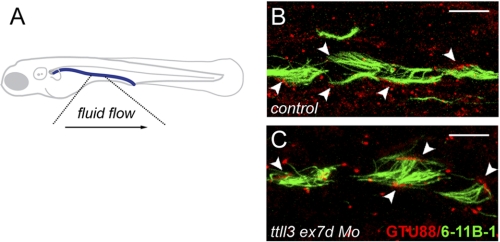FIGURE 4.
Randomization of multicilia orientation in ttll3 morphants. A, schematic view of the zebrafish indicating the direction of fluid flow in the highlighted area sampled to determine multicilia orientation. B and C, pronephric cilia in 2.5-day-old larvae injected with control morpholino (B) and ttll3ex7dMo (C) and double immunolabeled to reveal the axonemes (mAb 6-11B-1; green) and basal bodies (γ-tubulin-specific mAb GTU88). Note that axonemes and basal bodies of all wild type multicilia (B) are oriented to the posterior, whereas ttll3 morphants, basal bodies, and axonemes (C) orientation of some cilia (arrowheads) is reversed toward the anterior. Scale bars = 10 μm.

